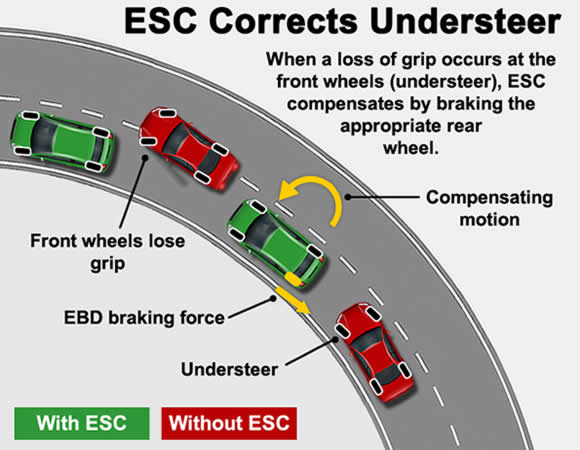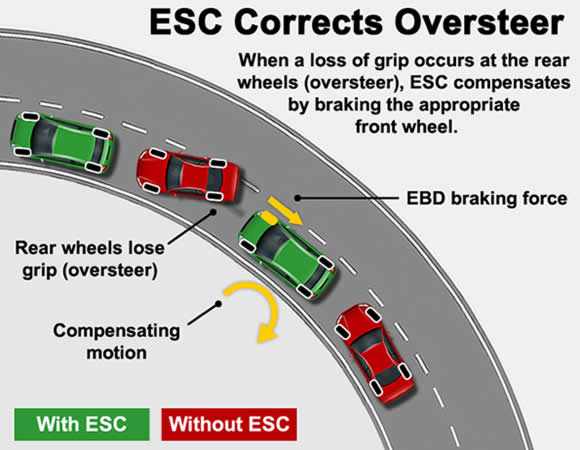How Does ESC Work in Cars
ESC (Electronic Stability Control) is a computerised vehicle stability system that constantly monitors your car’s steering angle, vehicle direction and speed. This guide explains how the ESC system works in cars.
Sensors Used by Electronic Stability Control
ESC works by use of various sensors in and around the vehicle. The main sensors involved in the operation of ESC are:
- Wheel speed sensor: One wheel speed sensor is located at each wheel. Each sensor measures the rotational speed of the wheel. Data from all four sensors is calculated along with engine speed to determine inconsistencies.
- Steering wheel angle sensor: This sensor is located in the steering column and is used to determine where the driver is intending to steer. The data is used to compare the direction that the driver wants to steer with the direction that the car is actually traveling in.
- Yaw rate sensor: The yaw rate sensor is a gyroscopic device located at the centre of the car and measures the rotation rate, or side-to-side motion of the vehicle. This data is compared to the steering angle sensor data to determine if any corrective action is required.
Information from the sensors is then sent to the car’s computer called the Electronic Control Unit (ECU). If the ECU determines any disparity in the data provided by the sensors, it will activate the appropriate stability system.
Driver Assist Systems used by ESC
ESC is made up from the following driver assist systems that help to keep your car stable and prevent loss of control:
ABS
ABS stands for ‘Anti-lock Braking System’ and uses wheel speed sensors to determine if your wheels are locking up while under braking. ABS is a system used to prevent the wheels from locking during heavy braking. Locking wheels means the driver is unable to steer the vehicle, so due to ABS preventing the wheels from locking, better control of the vehicle is possible.
When the ABS detects that a wheel is about to lock up and stop moving, the system releases the brake just to the point where the wheel begins to rotate again, then pressure is reapplied – just enough for optimal braking. This procedure operates in pulses, much faster than a human can do the job.
TCS
TCS stands for ‘Traction Control System’ and also uses the same wheel speed sensors. TCS is essentially the opposite of ABS in that when it detects that a wheel is slipping while under acceleration, the system reduces engine power and/or applies braking to the slipping wheel. When the slipping wheel gains traction with the road surface, TCS will stop reducing the speed of the wheel.
EBD
EBD stands for ‘Electronic Brake Force Distribution’ and by using wheels speed sensors it determines and allows for varying brake forces on individual wheels. When a car brakes, weight is shifted to the front meaning that that different brake forces are required for different wheels. If you car also happens to be cornering, EBD takes advantage of the yaw sensor to detect the pitch and roll of the vehicle while turning.
By making use of the various sensors, EBD also works with vehicle handling. If understeer or oversteer is detected while turning, the EBD system applies gentle braking to the tyre or tyres that are losing traction and aids in gaining traction. By dynamically controlling the brake force that is applied to each wheel, significantly better stability is achieved.
ESC Corrects Understeer
Understeer occurs when a car’s front wheels lose grip through a corner due to excessive speed. The front tyres often lose grip and start slipping due simultaneous braking and turning as excessive speed.

As can be seen in the diagram, the green car equipped with Electronic Stability Control (ESC) corrects left-corner understeer by braking the rear-left wheel. Wheel speed sensors, steering wheel angle sensors and yaw rate sensor allow the car’s ECU to detect the loss of control.
The ECU initiates the EBD system and by braking the rear-left wheel, the direction of the green car is corrected. The red car displays what occurs in the same situation but without having ESC fitted.
ESC Corrects Oversteer
Oversteer usually occurs on rear-wheel-drive cars and is the result of the car cornering with too much power applied to the rear wheels. Unlike understeer, the front tyres have traction but the rear of the car rotates and essentially tries to overtake the front of the car.

The green car in this diagram is equipped with ESC and is correcting left-corner oversteer by braking the front-right wheel. The ECU takes data from the various sensors and detects instability which results in the EBD system braking the front-right wheel.
This braking force compensates the direction of the green car and corrects its path. The red car displays what occurs in the with oversteer, but without having ESC fitted.
ESC (or its various other names) often takes corrective action so quickly that most drivers are unaware of of its effect. As a result, drivers do not usually perceive the need for steering corrections, unless they’re are driving in a manor beyond the system’s ability.
| More about Electronic Stability Control (ESC) |
|---|